Preparation and Application of Molecularly Imprinted Monolithic Extraction Column for the Selective Microextraction of Multiple Macrolide Antibiotics from Animal Muscles
Abstract
1. Introduction
2. Materials and Methods
2.1. Reagents and Materials
2.2. Preparation of MIMC
2.3. Equipments of Characterization
2.4. Binding Assays
2.5. Sample Preparation
2.6. HPLC and LC-MS/MS Analysis
3. Results and Discussion
3.1. Preparation of MIMC
3.2. Characterization of MIMC
3.3. Binding Assays
3.4. Optimization of MIPMME Procedure
3.4.1. Packing Volume
3.4.2. Loading Solvent
3.4.3. Washing Solution
3.4.4. Eluting Solution
3.4.5. Class-Specificity of MIMC
3.5. Comparison of Different Cleanup Methods
3.6. Reusability of MIMC
3.7. Application of MIMC in Animal Foodstuff
4. Conclusions
Supplementary Materials
Author Contributions
Funding
Conflicts of Interest
References
- Aarestrup, F.M.; Carstensen, B. Effect of tylosin used as a growth promoter on the occurrence of macrolide-resistant enterococci and staphylococci in pigs. Microb. Drug Resist. 1998, 4, 307–312. [Google Scholar] [CrossRef] [PubMed]
- Situ, C.; Elliott, C.T. Simultaneous and rapid detection of five banned antibiotic growth promoters by immunoassay. Anal. Chim. Acta 2005, 529, 89–96. [Google Scholar] [CrossRef]
- Viba, M.; Marie Claude, H.; Sandy, S.G. Airborne allergic contact dermatitis from tylosin in pharmacy compounders and cross-sensitization to macrolide antibiotics. Dermatitis 2012, 23, 227–230. [Google Scholar]
- Aarestrup, F.M. Association between the consumption of antimicrobial agents in animal husbandry and the occurrence of resistant bacteria among food animals. Int. J. Antimicrob. Agents 1999, 12, 279–285. [Google Scholar] [CrossRef]
- Pyörälä, S.; Baptiste, K.E.; Catry, B.; Duijkeren, E.V.; Greko, C.; Moreno, M.A.; Rantala, M.; Ružauskas, M.; Sanders, P. Macrolides and lincosamides in cattle and pigs: Use and development of antimicrobial resistance. Vet. J. 2014, 200, 230–239. [Google Scholar] [CrossRef] [PubMed]
- Commission of the European Communities. Official Journal of the European Communities, No 37/2010 on Pharmacologically Active Substances and Their Classification Regarding Maximum Residue Limits in Foodstuffs of Animal Origin. 2009. Available online: https://ec.europa.eu/health/sites/health/files/files/eudralex/vol-5/reg_2010_37/reg_2010_37_en.pdf (accessed on 18 June 2019).
- United States Department of Agriculture. Veterinary Drug MRL Database. Available online: http://www.mrldatabase.com/default.cfm (accessed on 18 June 2019).
- Ministry of Agriculture, People’s Republic of China. Bulletin 235. 2002. Available online: http://jiuban.moa.gov.cn/zwllm/tzgg/gg/200302/t20030226_59300.htm (accessed on 18 June 2019).
- Ministry of Agriculture, People’s Republic of China. Bulletin 168. 2001. Available online: http://jiuban.moa.gov.cn/zwllm/zqyj/201711/t20171102_5858835.htm (accessed on 18 June 2019).
- Commission of the European Communities. Official Journal of the European Communities, Council Regulation 2821/98, legislation L351: 4. 1998. Available online: https://publications.europa.eu/en/publication-detail/-/publication/48d54345-fbcd-49ff-99b4-d5b4bf2106a4/language-en (accessed on 18 June 2019).
- Habibi, B.; Ghorbel-Abid, I.; Lahsini, R.; Chehimi, B.H.D.; Trabelsi-Ayadi, M. Development and validation of a rapid HPLC method for multiresidue determination of erythromycin, clarithromycin, and azithromycin in aquaculture fish muscles. Acta Chromatogr. 2017, 31. [Google Scholar] [CrossRef]
- Tao, Y.; Yu, G.; Chen, D.; Pan, Y.; Liu, Z.; Wei, H.; Peng, D.; Huang, L.; Wang, Y.; Yuan, Z. Determination of 17 macrolide antibiotics and avermectins residues in meat with accelerated solvent extraction by liquid chromatography–tandem mass spectrometry. J. Chromatogr. B 2012, 897, 64–71. [Google Scholar] [CrossRef]
- Jia, W.; Shi, L.; Chu, X.; Chang, J.; Chen, Y.; Zhang, F. A strategy for untargeted screening of macrolides and metabolites in bass by liquid chromatography coupled to quadrupole orbitrap mass spectrometry. Food Chem. 2018, 262, 110–117. [Google Scholar] [CrossRef]
- Chen, D.; Yu, J.; Tao, Y.; Pan, Y.; Xie, S.; Huang, L.; Peng, D.; Wang, X.; Wang, Y.; Liu, Z. Qualitative screening of veterinary anti-microbial agents in tissues, milk, and eggs of food-producing animals using liquid chromatography coupled with tandem mass spectrometry. J. Chromatogr. B 2016, 1017–1018, 82–88. [Google Scholar] [CrossRef] [PubMed]
- Jin, Y.; Zhang, J.; Zhao, W.; Zhang, W.; Wang, L.; Zhou, J.; Li, Y. Development and validation of a multiclass method for the quantification of veterinary drug residues in honey and royal jelly by liquid chromatography–tandem mass spectrometry. Food Chem. 2017, 221, 1298–1307. [Google Scholar] [CrossRef] [PubMed]
- Du, L.J.; Yi, L.; Ye, L.H.; Chen, Y.B.; Cao, J.; Peng, L.Q.; Shi, Y.T.; Wang, Q.Y.; Hu, Y.H. Miniaturized solid-phase extraction of macrolide antibiotics in honey and bovine milk using mesoporous MCM-41 silica as sorbent. J. Chromatogr. A 2018, 1537, 10–20. [Google Scholar] [CrossRef] [PubMed]
- Zhou, W.; Ling, Y.; Liu, T.; Zhang, Y.; Li, J.; Li, H.; Wu, W.; Jiang, S.; Feng, F.; Yuan, F. Simultaneous determination of 16 macrolide antibiotics and 4 metabolites in milk by using Quick, Easy, Cheap, Effective, Rugged, and Safe extraction (QuEChERS) and high performance liquid chromatography tandem mass spectrometry. J. Chromatogr. B 2017, 1061-1062, 411–420. [Google Scholar] [CrossRef] [PubMed]
- García-Mayor, M.A.; Gallego-Picó, A.; Garcinuño, R.M.; Fernández-Hernando, P.; Durand-Alegría, J.S. Matrix solid-phase dispersion method for the determination of macrolide antibiotics in sheep’s milk. Food Chem. 2012, 134, 553–558. [Google Scholar] [CrossRef]
- Dubois, M.; Fluchard, D.; Sior, E.; Delahaut, P. Identification and quantification of five macrolide antibiotics in several tissues, eggs and milk by liquid chromatography–electrospray tandem mass spectrometry. J. Chromatogr. B 2001, 753, 189–202. [Google Scholar] [CrossRef]
- Yang, S.; Carlson, K.H. Solid-phase extraction–high-performance liquid chromatography–ion trap mass spectrometry for analysis of trace concentrations of macrolide antibiotics in natural and waste water matrices. J. Chromatogr. A 2004, 1038, 141–155. [Google Scholar] [CrossRef] [PubMed]
- Boulanouar, S.; Combès, A.; Mezzache, S.; Pichon, V. Synthesis and application of molecularly imprinted silica for the selective extraction of some polar organophosphorus pesticides from almond oil. Anal. Chim. Acta 2018, 1018, 35–44. [Google Scholar] [CrossRef] [PubMed]
- Yang, J.; Li, Y.; Huang, C.; Jiao, Y.; Ji, C. A phenolphthalein-dummy template molecularly imprinted polymer for highly selective extraction and clean-up of bisphenol A in complex biological, environmental and food samples. Polymers 2018, 10, 1150. [Google Scholar] [CrossRef] [PubMed]
- Geng, L.; Kou, X.; Lei, J.; Su, H.; Ma, G.; Su, Z. Preparation, characterization and adsorption performance of molecularly imprinted microspheres for erythromycin using suspension polymerization. J. Chem. Technol. Biot. 2012, 87, 635–642. [Google Scholar] [CrossRef]
- Song, X.; Zhou, T.; Li, J.; Su, Y.; Xie, J.; He, L. Determination of macrolide antibiotics residues in pork using molecularly imprinted dispersive solid-phase extraction coupled with LC-MS/MS. J. Sep. Sci. 2018, 41, 1138–1148. [Google Scholar] [CrossRef]
- Zheng, Y.; Liu, Y.; Guo, H.; He, L.; Fang, B.; Zeng, Z. Molecularly imprinted solid-phase extraction for determination of tilmicosin in feed using high performance liquid chromatography. Anal. Chim. Acta 2011, 690, 269–274. [Google Scholar] [CrossRef]
- Ji, S.; Li, T.; Yang, W.; Shu, C.; Li, D.; Wang, Y.; Ding, L. A hollow porous molecularly imprinted polymer as a sorbent for the extraction of 7 macrolide antibiotics prior to their determination by HPLC-MS/MS. Microchim. Acta 2018, 185, 203. [Google Scholar] [CrossRef] [PubMed]
- Zhou, Y.; Zhou, T.; Jin, H.; Jing, T.; Song, B.; Zhou, Y.; Mei, S.; Lee, Y.I. Rapid and selective extraction of multiple macrolide antibiotics in foodstuff samples based on magnetic molecularly imprinted polymers. Talanta 2015, 137, 1–10. [Google Scholar] [CrossRef] [PubMed]
- Zhaohui, Z.; Xiao, Y.; Huabin, Z.; Minlei, Z.; Lijuan, L.; Yufang, H.; Shouzhuo, Y. Novel molecularly imprinted polymers based on multi-walled carbon nanotubes with binary functional monomer for the solid-phase extraction of erythromycin from chicken muscle. J. Chromatogr. B 2011, 879, 1617–1624. [Google Scholar]
- Song, X.; Zhou, T.; Liu, Q.; Zhang, M.; Meng, C.; Li, J.; He, L. Molecularly imprinted solid-phase extraction for the determination of ten macrolide drugs residues in animal muscles by liquid chromatography–tandem mass spectrometry. Food Chem. 2016, 208, 169–176. [Google Scholar] [CrossRef] [PubMed]
- Chao, M.; Hui, C.; Na, S.; Yong, Y.; Chen, H. Preparation of molecularly imprinted polymer monolith with an analogue of thiamphenicol and application to selective solid-phase microextraction. Food Anal. Method. 2012, 5, 1267–1275. [Google Scholar]
- Liu, Z.S.; Xu, Y.L.; Yan, C.; Gao, R.Y. Preparation and characterization of molecularly imprinted monolithic column based on 4-hydroxybenzoic acid for the molecular recognition in capillary electrochromatography. Anal. Chim. Acta 2004, 523, 243–250. [Google Scholar] [CrossRef]
- Zhao, X.Y.; Zhang, H.W.; Liang, Z.J.; Shu, Y.P.; Liang, Y. Selective recognition of triamterene in biological samples by molecularly imprinted monolithic column with a pseudo template employed. J. Sep. Sci. 2013, 36, 1501–1508. [Google Scholar] [CrossRef] [PubMed]
- Liu, X.; Zhu, Q.; Chen, H.; Zhou, L.; Dang, X.; Huang, J. Preparation of 2,4-dichlorophenoxyacetic acid imprinted organic–inorganic hybrid monolithic column and application to selective solid-phase microextraction. J. Chromatogr. B 2014, 951–952, 32–37. [Google Scholar] [CrossRef] [PubMed]
- Zheng, M.M.; Gong, R.; Zhao, X.; Feng, Y.Q. Selective sample pretreatment by molecularly imprinted polymer monolith for the analysis of fluoroquinolones from milk samples. J. Chromatogr. A 2010, 1217, 2075–2081. [Google Scholar] [CrossRef] [PubMed]
- Vlakh, E.G.; Stepanova, M.A.; Pisarev, O.A.; Tennikova, T.B. Preparation and characterization of macroporous monoliths imprinted with erythromycin. J. Sep. Sci. 2015, 38, 2763–2771. [Google Scholar] [CrossRef]
- Zhou, T.; Yang, H.; Jin, Z.; Liu, Q.; Song, X.; He, L.; Fang, B.; Meng, C. Determination of azithromycin residue in pork using a molecularly imprinted monolithic microcolumn coupled to liquid chromatography with tandem mass spectrometry. J. Sep. Sci. 2016, 39, 1339–1346. [Google Scholar] [CrossRef] [PubMed]
- Wang, Z.; Song, X.; Zhou, T.; Bian, K.; Zhang, F.; He, L.; Liu, Q.Y. Simultaneous determination of ten macrolides drugs in feeds by high performance liquid chromatography with evaporation light scattering detection. RSC Adv. 2014, 5, 1491–1499. [Google Scholar] [CrossRef]
- Yan, H.; Row, H.K. Characteristic and Synthetic Approach of Molecularly Imprinted Polymer. Int. J. Mol. Sci. 2006, 7, 155–178. [Google Scholar] [CrossRef]
- Zhu, Q.Z.; Degelmann, P.; Niessner, R.; Knopp, D. Selective Trace Analysis of Sulfonylurea Herbicides in Water and Soil Samples Based on Solid-Phase Extraction Using a Molecularly Imprinted Polymer. Environ. Sci. Technol. 2002, 36, 5411–5420. [Google Scholar] [CrossRef] [PubMed]
- Ji, W.; Zhang, M.; Wang, T.; Wang, X.; Zheng, Z.; Gong, J. Molecularly imprinted solid-phase extraction method based on SH-Au modified silica gel for the detection of six Sudan dyes in chili powder samples. Talanta 2017, 165, 18–26. [Google Scholar] [CrossRef] [PubMed]
- Berrada, H.; Moltó, J.C.; Mañes, J.; Font, G. Determination of aminoglycoside and macrolide antibiotics in meat by pressurized liquid extraction and LC-ESI-MS. J. Sep. Sci. 2015, 33, 522–529. [Google Scholar] [CrossRef] [PubMed]
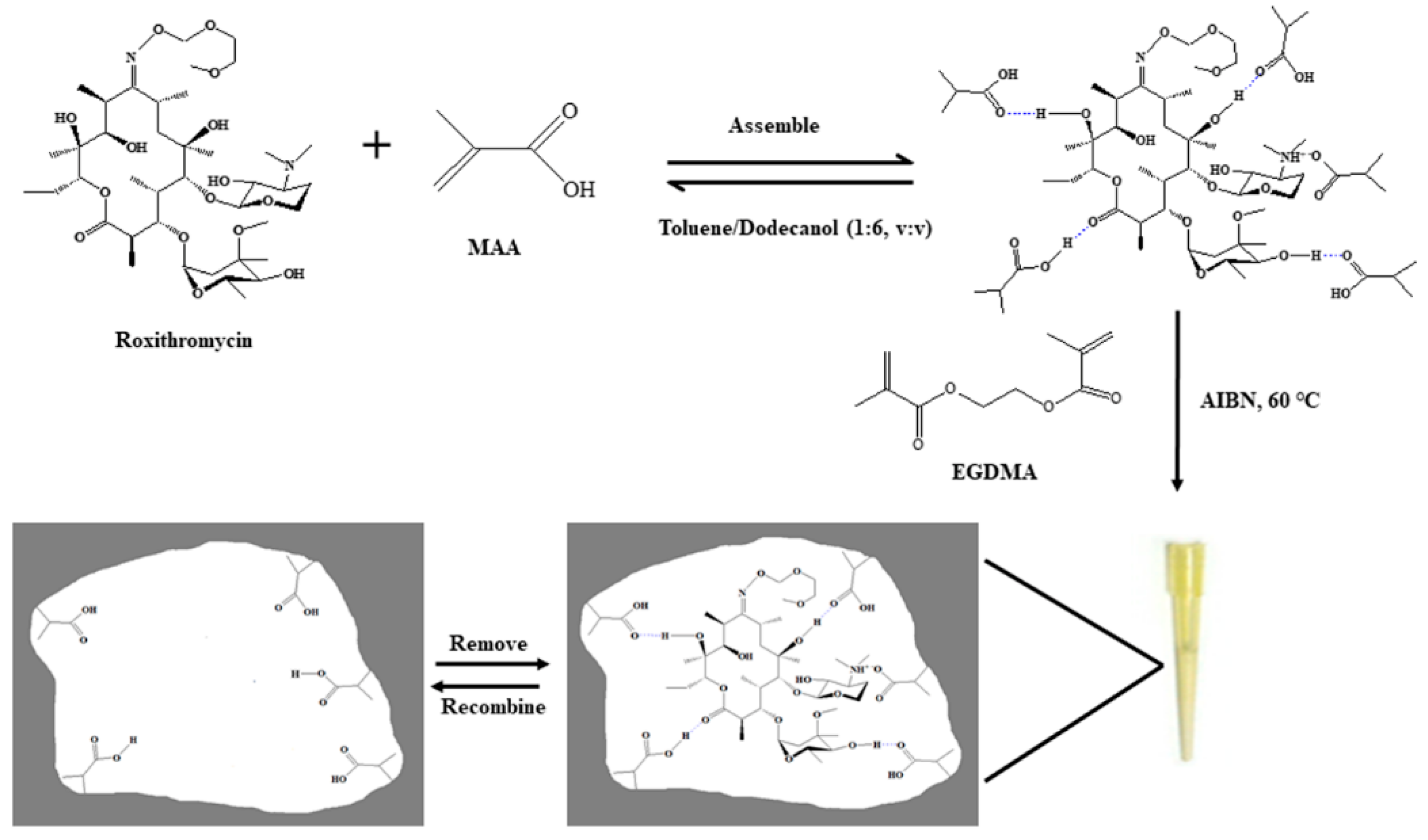
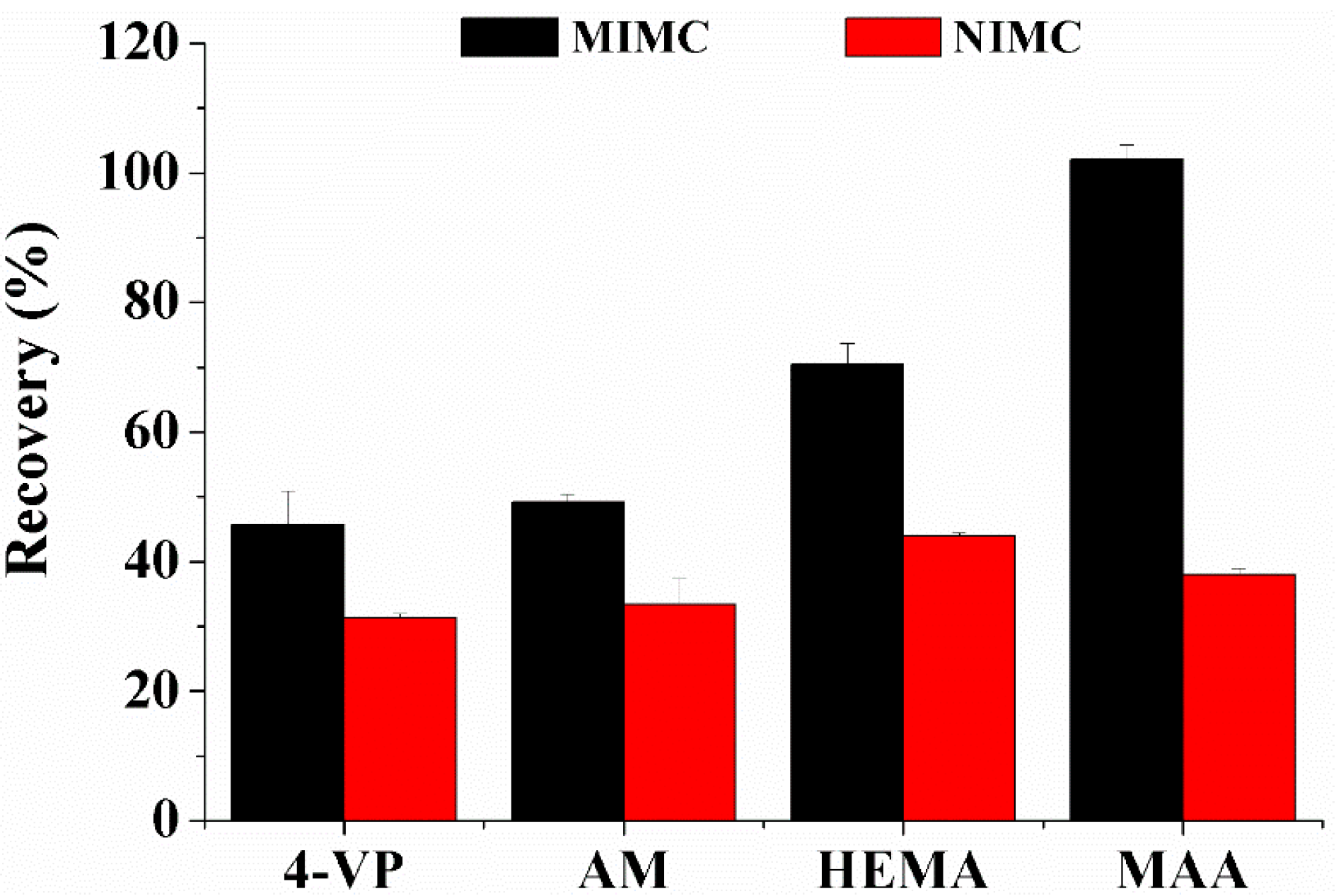
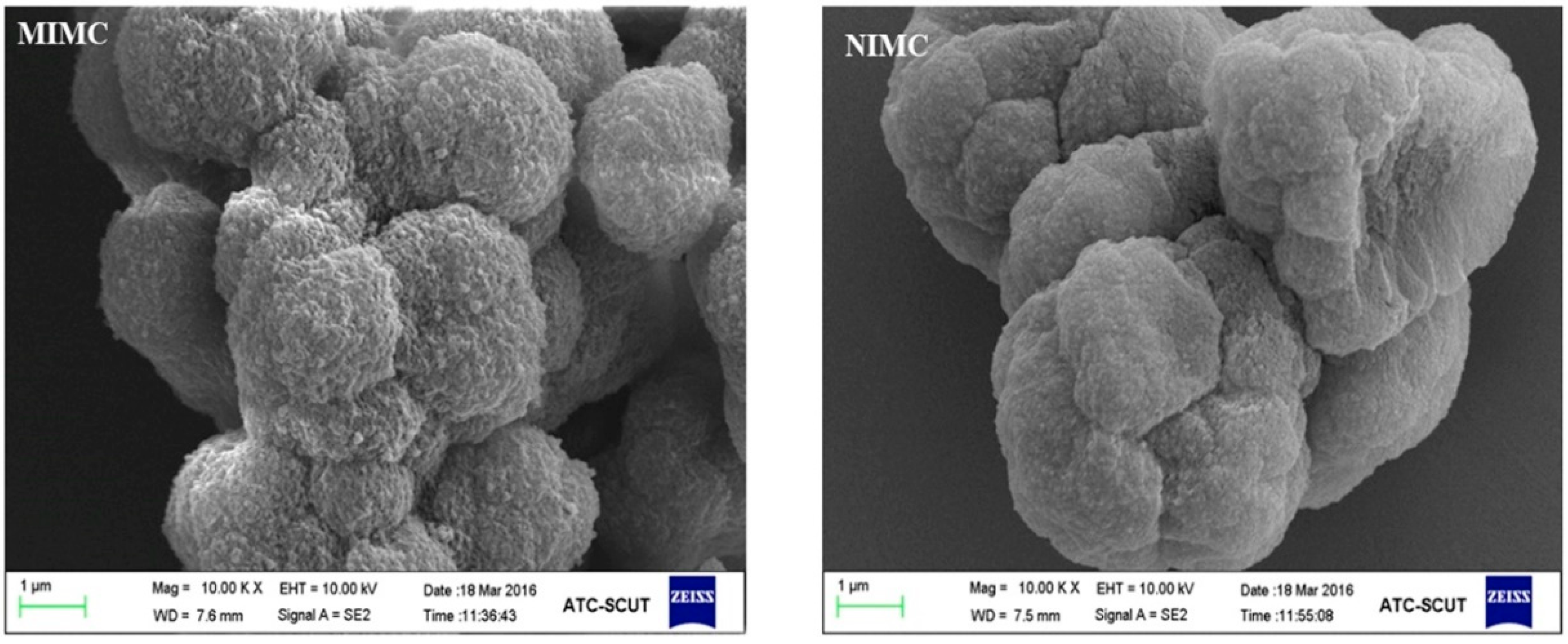
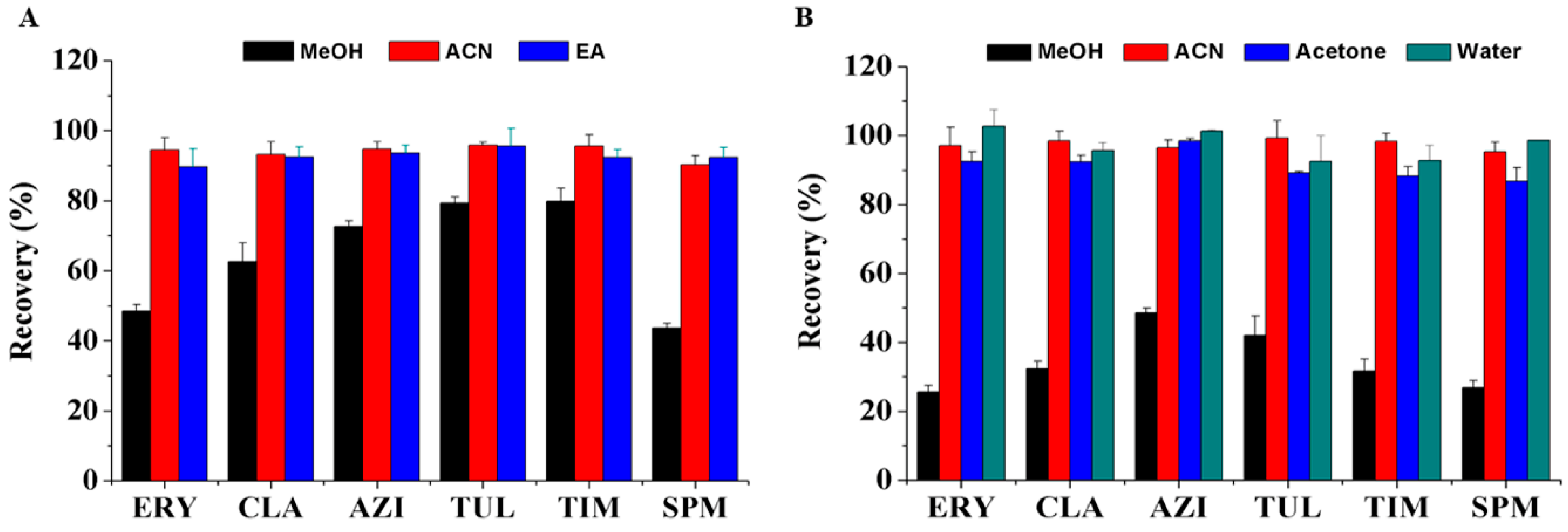
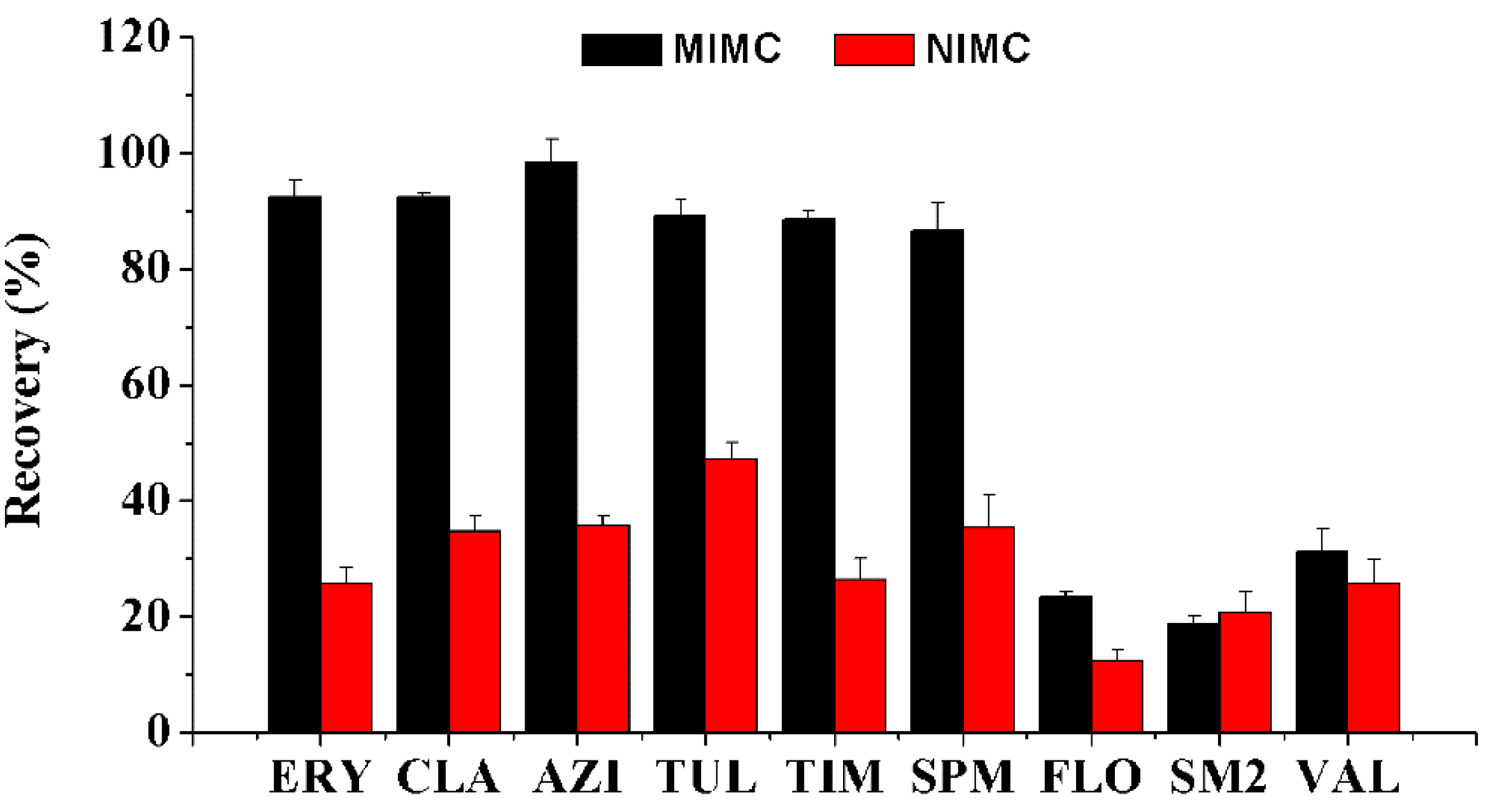
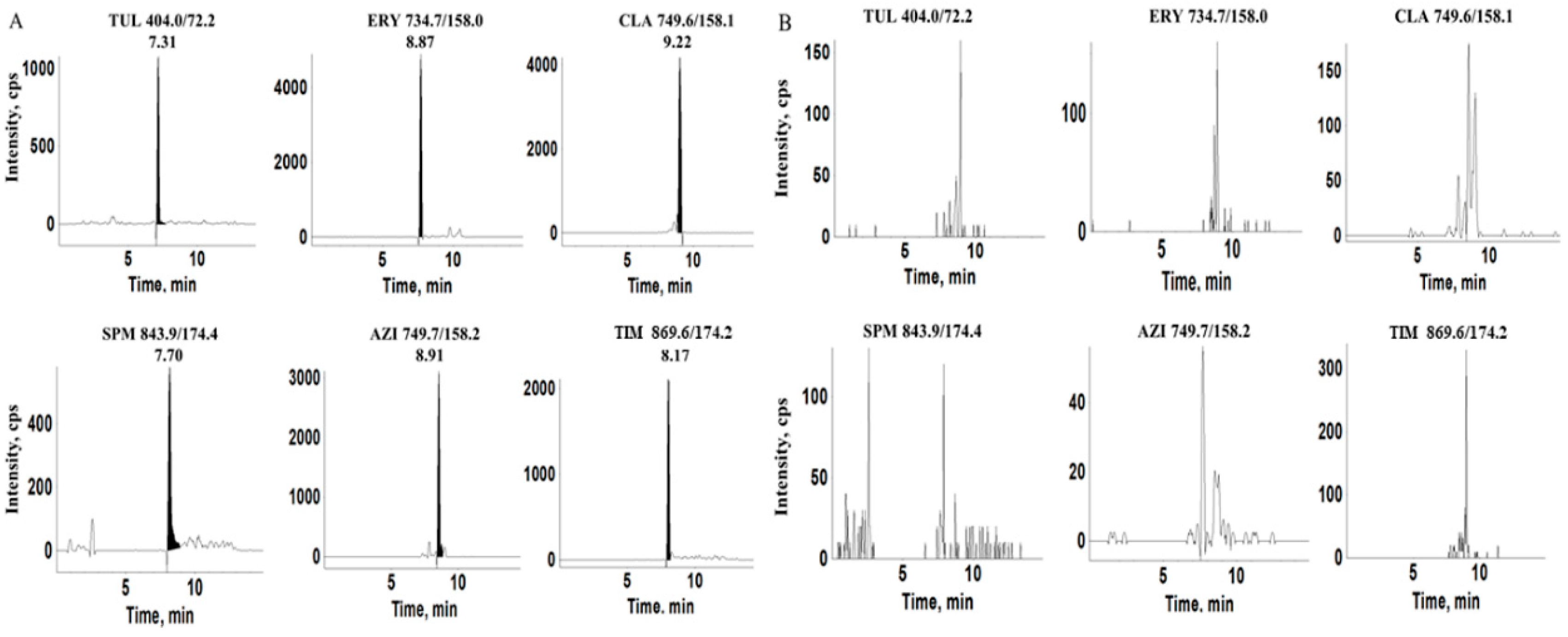
| Compound | Polymer b | Single | Multiple | ||
|---|---|---|---|---|---|
| Q (mg/g) c | IF d | Q (mg/g) | IF | ||
| Roxithromycin | MIMC | 12.0 | 2.8 | 3.4 | 1.7 |
| NIMC | 4.3 | 1.9 | |||
| Clarithromycin | MIMC | 11.5 | 2.6 | 3.5 | 2.3 |
| NIMC | 4.5 | 1.5 | |||
| Erythromycin | MIMC | 11.5 | 2.3 | 8.2 | 2.1 |
| NIMC | 5.0 | 3.7 | |||
| Azithromycin | MIMC | 12.4 | 1.7 | 3.4 | 1.8 |
| NIMC | 7.2 | 1.9 | |||
| Tulathromycin | MIMC | 25.2 | 1.6 | 18.0 | 1.4 |
| NIMC | 18.4 | 12.9 | |||
| Tilmicosin | MIMC | 17.1 | 1.8 | 5.1 | 1.6 |
| NIMC | 9.3 | 3.2 | |||
| Spiramycin | MIMC | 10.2 | 2.0 | 4.8 | 1.8 |
| NIMC | 5.1 | 2.6 | |||
| Compound | Samples | Linearity (r2) | LOD b (μg/kg) | LOQ c (μg/kg) | Intra-Day Recovery (%RSD, n = 6) d | Inter-Day Recovery (%RSD, n = 18) | ||||
|---|---|---|---|---|---|---|---|---|---|---|
| 5 μg/kg | 10 μg/kg | 25 μg/kg | 5 μg/kg | 10 μg/kg | 25 μg/kg | |||||
| Erythromycin | chicken | 0.9977 | 0.5 | 2.0 | 80.4(4.2) | 82.8(2.7) | 85.4(1.7) | 81.2(5.1) | 83.3(2.4) | 86.1(2.5) |
| pork | 0.9984 | 0.5 | 2.0 | 81.7(3.8) | 83.4(3.1) | 84.8(5.9) | 82.7(4.4) | 83.9(3.6) | 85.6(6.7) | |
| beef | 0.9962 | 0.5 | 2.0 | 76.8(7.2) | 78.6(3.4) | 82.1(4.9) | 78.2(10.4) | 79.1(5.6) | 83.7(7.1) | |
| Clarithromycin | chicken | 0.9995 | 0.5 | 2.0 | 84.9(6.3) | 85.7(2.1) | 88.4(1.6) | 85.3(8.2) | 84.9(3.6) | 89.7(2.4) |
| pork | 0.9992 | 0.5 | 2.0 | 82.6(8.1) | 84.7(1.8) | 85.1(4.7) | 80.2(9.8) | 84.1(1.1) | 86.4(5.3) | |
| beef | 0.9989 | 0.5 | 2.0 | 80.5(4.7) | 82.6(0.7) | 84.6(4.2) | 82.9(5.1) | 83.7(2.6) | 85.1(3.9) | |
| Tulathromycin | chicken | 0.9992 | 1.0 | 5.0 | 75.8(5.8) | 78.1(3.4) | 79.1(2.3) | 76.1(3.7) | 78.6(1.9) | 80.3(2.7) |
| pork | 0.9994 | 1.0 | 5.0 | 76.8(1.2) | 78.8(6.1) | 80.2(1.9) | 77.5(1.6) | 79.2(3.4) | 81.2(2.1) | |
| beef | 0.9988 | 1.0 | 5.0 | 75.3(8.3) | 76.7(2.8) | 78.3(5.4) | 76.9(5.8) | 78.1(4.2) | 79.8(2.9) | |
| Azithromycin | chicken | 0.9963 | 0.5 | 2.0 | 83.5(2.5) | 84.8(2.2) | 85.7(3.6) | 83.9(1.4) | 84.4(3.6) | 87.4(7.2) |
| pork | 0.9998 | 0.5 | 2.0 | 85.1(7.3) | 88.4(5.4) | 91.7(6.7) | 86.3(8.1) | 89.1(4.5) | 92.8(3.1) | |
| beef | 0.9992 | 0.5 | 2.0 | 78.4(5.7) | 80.2(6.5) | 90.6(5.0) | 79.6(6.4) | 83.2(8.2) | 86.1(4.6) | |
| Spiramycin | chicken | 0.9961 | 1.0 | 5.0 | 84.6(3.2) | 86.9(1.2) | 87.6(1.1) | 85.3(5.8) | 87.2(2.7) | 87.6(4.1) |
| pork | 0.9987 | 1.0 | 5.0 | 82.3(4.1) | 83.4(8.3) | 85.8(1.7) | 83.5(2.5) | 84.8(7.2) | 85.7(3.6) | |
| beef | 0.9992 | 1.0 | 5.0 | 79.2(4.6) | 81.8(6.7) | 83.6(1.5) | 78.2(5.7) | 83.4(8.9) | 84.3(2.1) | |
| Tilmicosin | chicken | 0.9930 | 0.5 | 2.0 | 85.1(1.5) | 89.2(7.4) | 91.8(2.5) | 86.5(3.2) | 90.6(7.1) | 91.2(6.2) |
| pork | 0.9943 | 0.5 | 2.0 | 82.5(3.4) | 86.6(1.9) | 90.7(3.6) | 81.2(4.5) | 87.2(2.5) | 89.1(7.8) | |
| beef | 0.9985 | 0.5 | 2.0 | 79.4(1.9) | 84.2(6.4) | 88.1(2.7) | 78.2(2.2) | 86.2(8.1) | 90.3(4.5) | |
| Preparation a | Analytical Method b | Matrix | Analyte c | LOD (μg/kg) d | Recovery (%) | Ref. |
|---|---|---|---|---|---|---|
| PLE | LC-MS/MS | chicken | SPM, TIM, TYL | 1.0–6.0 | 77.1–94.0 | [41] |
| ASE | LC-MS/MS | pork, kidney, liver | SPM, OLE, ERE, DOR, IVE, TIM, ERY, ROX, CLA, KIT, MED | 0.2–0.6 | 76.0–102 | [12] |
| MWNTs-MISPE | HPLC-UVD | chicken | ERY | - | 85.3–95.8 | [28] |
| MMISPE | HPLC-UVD | pork, fish, shrimp | ERY, OLE, AZI, TIM, CLA, ROX | 1.5–20 | 64.8–84.2 | [27] |
| HPMIP-DSPE | LC-MS/MS | honey | AZI, SPM, TIM, CLA, JOS, ROX, TYL | 0.003–0.017 | 88.0–117 | [26] |
| MISPE | LC-MS/MS | pork, beef, chicken | AZI, TUL, SPM, TIM, ERY, CLA, ROX, MED, JOS, KIT | 0.1–0.4 | 60.7–100 | [29] |
| MIPMME | LC-MS/MS | pork, beef, chicken | CLA, ERY, ZAI, TUL, TIM, SPM | 0.5–1.0 | 76.1–92.8 | This work |
© 2019 by the authors. Licensee MDPI, Basel, Switzerland. This article is an open access article distributed under the terms and conditions of the Creative Commons Attribution (CC BY) license (http://creativecommons.org/licenses/by/4.0/).
Share and Cite
Song, X.; Zhou, T.; Zhang, J.; Su, Y.; Zhou, H.; He, L. Preparation and Application of Molecularly Imprinted Monolithic Extraction Column for the Selective Microextraction of Multiple Macrolide Antibiotics from Animal Muscles. Polymers 2019, 11, 1109. https://doi.org/10.3390/polym11071109
Song X, Zhou T, Zhang J, Su Y, Zhou H, He L. Preparation and Application of Molecularly Imprinted Monolithic Extraction Column for the Selective Microextraction of Multiple Macrolide Antibiotics from Animal Muscles. Polymers. 2019; 11(7):1109. https://doi.org/10.3390/polym11071109
Chicago/Turabian StyleSong, Xuqin, Tong Zhou, Jiahui Zhang, Yijuan Su, Hao Zhou, and Limin He. 2019. "Preparation and Application of Molecularly Imprinted Monolithic Extraction Column for the Selective Microextraction of Multiple Macrolide Antibiotics from Animal Muscles" Polymers 11, no. 7: 1109. https://doi.org/10.3390/polym11071109
APA StyleSong, X., Zhou, T., Zhang, J., Su, Y., Zhou, H., & He, L. (2019). Preparation and Application of Molecularly Imprinted Monolithic Extraction Column for the Selective Microextraction of Multiple Macrolide Antibiotics from Animal Muscles. Polymers, 11(7), 1109. https://doi.org/10.3390/polym11071109






